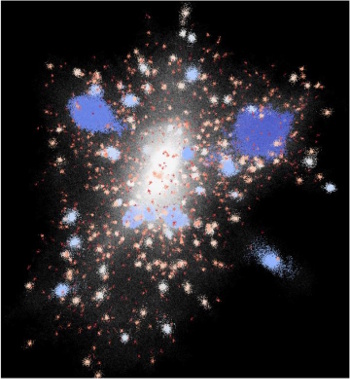Simulating Galaxy Formation
December 10, 2015
General purpose computers, such as
desktop computers and most
mainframe computers, are useful because they are general purpose; that is, they'll do nearly everything you want them to do, from printing
paychecks, keeping your
calendar, and
calculating pi to millions of
decimal places. Although
computing hardware has become considerably faster through the
decades, it's always slower than desired for certain applications. For that reason, special-purpose computers are built that are very good at doing just one, specific calculation.
Alan Turing's Bombe, an
electromechanical computer used for
cryptanalysis during
World War II, is an early example of such a special-purpose computer. I'm certain that
government agencies have modern equivalents of this type of device for their own
code-breaking efforts.
Bitcoin mining is another application for special-purpose computers.
Today's special purpose computers are constructed from
logic array integrated circuits known as
field-programmable gate arrays (FPGAs) and
application-specific integrated circuits (ASICs). Many years ago I met a
scientist who was building a special-purpose computer with such chips to
simulate the
formation and evolution of galaxies. Since these were the dark days before
astronomers discovered the importance of
dark matter and
dark energy in such simulations, the computations were simpler than they would be today.
Advances in
technology have given us
supercomputers that perform nearly as well as special-purpose computers for most simulations. Fast,
multi-core CPUs, the use of
graphics processing units (GPUs), and
massively parallel processing have boosted the performance of supercomputers. Of equal importance is the availability of fast and dense
memory.
Oak Ridge National Laboratory (ORNL) has one of the world's most powerful supercomputers. This supercomputer, appropriately called
Titan, has a
theoretical peak performance of more than 20
petaflops; that is, 20 quadrillion
floating point calculations per second. The ORNL web site describes this computation performance as equivalent to the
world's 7 billion people doing 3 million calculations per second. I wrote about Titan in a
previous article (Titan Supercomputer, November 19, 2012).

The ORNL Titan supercomputer.
Titan is built from AMD Opteron CPUs and Nvidia Tesla GPUs, and it runs a variant of Linux.
(ORNL image.)
Scientists from
Argonne National Laboratory (Lemont, Illinois), the
University of Chicago (Chicago, Illinois), and
Los Alamos National Laboratory (Los Alamos, New Mexico), have used Titan to model most of the evolution of the
universe.[1-2] This simulation started at 50 million years after the
Big Bang and continued to the universe that we see today. Over the course of these 13.8 billion years of the universe,
primordial matter aggregated into our present visage of
galaxies,
stars, and
planets.
This
cosmological N-body simulation, called the "Q Continuum," is one of the largest ever performed.[1] This simulation, which consumed nearly 90% of the functionality of Titan, was led by scientists at Argonne National Laboratory.[1-2] Observations of distant galaxies at early times in the history of the universe show that clumping of matter began very uniformly.[2] Says Argonne physicist,
Katrin Heitmann,
"Gravity acts on the dark matter, which begins to clump more and more, and in the clumps, galaxies form."[2]
The Q Continuum simulation was run using the
Hardware/Hybrid Accelerated Cosmology Code (HACC)
software written in 2008. HACC was written to be adaptable to different
supercomputer architectures.[2] The simulation generated two and a half
petabytes of
data, and such a data lode can't be analyzed quickly. The
data analysis will take several years, and it's expected to generate insights into many
astrophysical phenomena.[2] As Heitmann explains,
"We can use this data to look at why galaxies clump this way, as well as the fundamental physics of structure formation itself."[2]

Galaxies with surrounding halos, as calculated by the Q Continuum simulation. Sub-halos are shown by different colors.
(DOE/Argonne National Laboratory image by Heitmann et. al..)
The Q Continuum simulation involved half a trillion
particles, and the calculations were done on a fundamental
cubical volume element having sides 100,000
kilometers long.[2] It simulated a portion of the universe having a total volume of 1300
megaparsecs cubed.[1] This makes the Q Continuum simulation one of the largest cosmological simulations at such high resolution.[1-2]
This Q Continuum simulation was funded by the
United States Department of Energy Office of Science in its
Scientific Discovery through Advanced Computing initiative.[2]

Galaxy formation, as revealed by the the Q Continuum simulation. The matter in the universe is at first distributed uniformly. After a time, gravity acts on dark matter to clump the matter into galaxies. (DOE/Argonne National Laboratory image by Heitmann et. al. Click for larger image.)
References:
- Katrin Heitmann, Nicholas Frontiere, Chris Sewell, Salman Habib, Adrian Pope, Hal Finkel, Silvio Rizzi, Joe Insley, and Suman Bhattacharya, "The Q Continuum Simulation: Harnessing the Power of GPU Accelerated Supercomputers," The Astrophysical Journal Supplement Series, vol. 219, no. 2 (August 21, 2015), dx.doi.org/10.1088/0067-0049/219/2/34.
- Louise Lerner, "Researchers model birth of universe in one of largest cosmological simulations ever run," Argonne National Laboratory Press Release, October 29, 2015.
Permanent Link to this article
Linked Keywords: General purpose computer; desktop computer; mainframe computer; paycheck; calendar; calculation; calculating; pi; decimal place; computing hardware; decade; Alan Turing; Bombe; electromechanics; electromechanical; cryptanalysis; World War II; government agency; code-breaking; bitcoin mining; gate array; logic array; integrated circuit; field-programmable gate array; application-specific integrated circuit; scientist; computer simulation; simulate; formation and evolution of galaxies; astronomer; dark matter; dark energy; technology; supercomputer; multi-core processor; multi-core CPU; graphics processing unit; massively parallel processing; random-access memory; Oak Ridge National Laboratory; Titan supercomputer; theory; theoretical; petaflop; floating point calculations per second; world population; world's 7 billion people; AMD Opteron CPU; Nvidia Tesla GPU; UNICOS; variant of Linux; Argonne National Laboratory (Lemont, Illinois); University of Chicago (Chicago, Illinois); universe; Big Bang; primordial nuclide; primordial matter; galaxy; galaxies; star; planet; cosmology; cosmological; N-body simulation; Katrin Heitmann; gravity; Hardware/Hybrid Accelerated Cosmology Code; software; supercomputer architecture; petabyte; data; data analysis; astrophysics; astrophysical; phenomenon; phenomena; physics; galactic halo; particle; cube; cubical; volume element; kilometer; megaparsec; United States Department of Energy; Office of Science; Scientific Discovery through Advanced Computing; matter.